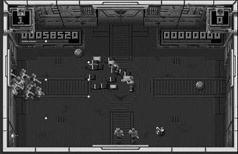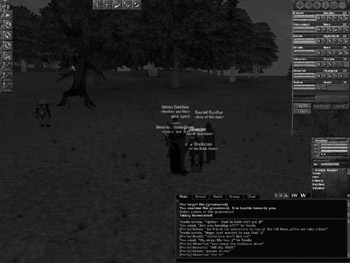The Forms
When looking at multi-player computer games, two groups of games immediately present themselves : games that are played by a number of gamers all in the same location and huddled around the same computer or console, and games that are played online by multiple players who are in significantly different locations. Though both are definitely multi-player experiences, these two types of games are extremely different and each present their own design challenges.
Single System Multi-Player
Due to the limitations of networking, multi-player games that occur around a single computer system have been popular and commercially viable for a good while longer than online games. These originally took the form of multiple players controlling their game-world surrogates in a shared view of the game-environment, with the earliest example being Pong and progressing through arcade games such as Mario Bros ., Gauntlet, Smash TV , many sports games, and all fighting games. These games are limited in that both players have to be constrained to relatively the same portion of the game-world so that they can both stay visible. Multi-player single-screen play can be further problematic when players have to wait for one another to perform certain actions. For example, in cooperative mode in Baldur s Gate: Dark Alliance, the other player must sit idle while one player manipulates his inventory. Some PC games, such as M.U.L.E., used a single screen with each player taking a turn at playing while the other players waited, referred to as hot seat play. A solution for the problem of constraining two or more players to the same location came with the advent of split-screen gaming, where each player has a section of the monitor devoted to displaying the portion of the game-world that is relevant to them at any given time. This includes such classics as Mario Kart , and continues today for games such as Centipede 3D or War of the Monsters . This last title is one of the latest in a long line of games to dynamically switch to non-split-screen when both players happen to be in the same location in the game-world.

Many early multi-player games, such as Smash TV , confined two players to the same portion of the game-world.
Split-screen is used even more extensively for single-machine adaptations of games that were originally designed to be played over a network, such as the death-match modes in Halo , Syphon Filter , or SOCOM . For these games, there is the distinct disadvantage that all players can see the location and status of the other players simply by looking at their portion of the screen. This may be unethical, but is hard to avoid when their view is right next to your own world-view. This is not detrimental to a game such as Mario Kart , but can often weaken the experience in a game like Halo, whose death-match gameplay is modeled after online, blind-play competition.
However, split-screen play cannot be considered unfair since all players have access to the same information about the other players status; the fact that it is split-screen simply makes it a different type of game. Some single-system games have tried to allow some degree of blind-play through various devious techniques. Robot Rascals included a deck of special cards that dictated the victory conditions for each player, with the cards kept secret until the end of the game. The Sega Dreamcast included a display in the controller that allowed players of football games to make their play selections without the other players seeing their choices. Despite the potential disadvantages in terms of blind-play, multi-player games that take place around one system have a tremendous advantage in terms of the social interaction they engender. Whenever you cluster a bunch of people, presumably already friends , around a single screen, they are guaranteed to talk to each other and play differently than if the other players were in another room or building. Anyone who has watched the verbal and physical interaction between players around a cart racer or a sports title can testify to this and how much fun players derive from such interaction. Though networked voice communication and other advances can help make players who are far away seem closer, nothing can compare to the physical proximity of your opponent for real human communication and camaraderie.
Online Multi-Player
Of course networked games provide a significantly more immersive player experience for the very reason that the other players are invisible to each other. For online games, players each have their own computers and are situated in separate locations and thus need to project themselves into the game-space much more, since none of the other players can see what they look like, hear what they are saying, or observe how they are acting. First-person shooters such as Unreal , Quake , Counter-Strike, and Battlefield 1942 work extremely well over networks, since the separation of the players enables blind-play in a way split-screen cannot, thus making these games much more challenging. Air combat simulations such as the classic Air Warrior are one of the oldest forms of networked multi-player games, and in spirit work mostly the same as shooter games. Many sports-style games ” including racing games and fighting games ” provide networked multi-player support in addition to their single-system multi-player games. Though this was originally true primarily on the PCs, the success of Xbox Live has made including a multi-player mode de rigueur in console games, at least where such gameplay makes sense.

Massively multi-player persistent online games such as Dark Age of Camelot create elaborate virtual worlds in which players can fully immerse themselves.
Massively multi-player persistent games (MMPs) such as Ultima Online , EverQuest , and Dark Age of Camelot have become increasingly popular in recent years , though the MUDs (multi- user dungeons/domains) that inspired them have existed for nearly three decades. These games provide the ultimate in immersive online gaming, with players spending an exceedingly large amount of time in complex virtual worlds. There they interact and form strong bonds with other players they have often never met in the physical world. Though these games are almost always engaged in by players alone in separate locations, the social ties that form between players make these games extremely social experiences. Indeed, playing MMPs can be such a lifestyle choice that many couples will play together, with women tending to enjoy them more than most games. These games are much more open -ended in their design, emphasizing multiple paths to success and allowing players to spend their time how they choose. Players can go on quests, get a job and build up a home, or just spend all their time socializing with the other people they meet there. Indeed, some have charged that theseMMPs are really just cleverly disguised chat rooms. However, Ultima Online and StarWars Galaxies lead designer Raph Koster is quick to point out that players will not play these games solely for the social experience. Since they can do that over e-mail or ICQ, there will be no incentive for them to keep playing the game (and paying the monthly subscription fee that most of these games charge) if all they are doing with the game is socializing. For it to be successful in the long term , the game must provide an interesting enough game that facilitates socialization in conjunction with other rewards.
Each of the different forms that multi-player games can take determine the kind of interaction players will have with each other while playing. This in turn dictates which type of games will best succeed in those forms. Having both players share a single view of the game-world demands cooperation between the players if they are going to progress to new areas. Having a split-screen means that, if the game is competitive, players will be unable to avoid seeing what the other players are doing. Having players at separate systems means they will be able to have proper blind-play but will be significantly hindered in their ability to interact with each other while playing the game, no matter what the game designer does to facilitate socialization. All these types of games can be fun if, from the start, the designer is fully cognizant of the strengths and weaknesses of the type of multi-player game he is building and designs the game to work optimally within that paradigm.
EAN: 2147483647
Pages: 189
- Structures, Processes and Relational Mechanisms for IT Governance
- Integration Strategies and Tactics for Information Technology Governance
- Linking the IT Balanced Scorecard to the Business Objectives at a Major Canadian Financial Group
- Governing Information Technology Through COBIT
- Governance in IT Outsourcing Partnerships